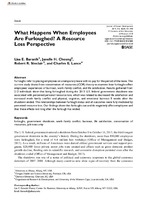| dc.contributor.author | Baranik, Lisa E. | |
| dc.contributor.author | Cheung, Janelle H. | |
| dc.contributor.author | Sinclair, Robert R. | |
| dc.contributor.author | Lance, Charles E. | |
| dc.date.accessioned | 2019-08-05T11:01:23Z | |
| dc.date.available | 2019-08-05T11:01:23Z | |
| dc.date.issued | 2019 | |
| dc.identifier.citation | Baranik, L. E., Cheung, J. H., Sinclair, R. R., & Lance, C. E. (2019). What Happens When Employees Are Furloughed? A Resource Loss Perspective. Journal of Career Development, 46(4), 381–394. https://doi.org/10.1177/0894845318763880 | en_US |
| dc.identifier.issn | 1556-0856 | |
| dc.identifier.uri | https://doi.org/10.1177/0894845318763880 | |
| dc.identifier.uri | http://hdl.handle.net/10566/4766 | |
| dc.description.abstract | Furloughs refer to placing employees on a temporary leave with no pay for the period of the leave. The
current study draws from conservation of resources (COR) theory to examine how furloughs affect
employees’ experiences of burnout, work–family conflict, and life satisfaction. Results gathered from
212 individuals show that being furloughed during the 2013 U.S. federal government shutdown was
associated with perceived personal resource loss, which was related to decreased life satisfaction and
increased work–family conflict and physical, cognitive, and emotional burnout 5 weeks after the
shutdown ended. The relationships between furlough status and all outcomes were fully mediated by
perceived resource loss. Our findings show that furloughs can and do negatively affect employees and
that these effects last long after the furlough has ended. | en_US |
| dc.language.iso | en | en_US |
| dc.publisher | Sage | en_US |
| dc.subject | Furloughs | en_US |
| dc.subject | Burnout | en_US |
| dc.subject | Job insecurity | en_US |
| dc.subject | Government shutdown | en_US |
| dc.subject | Work–family conflict | en_US |
| dc.title | What happens when employees are furloughed? A resource loss perspective | en_US |
| dc.type | Article | en_US |

